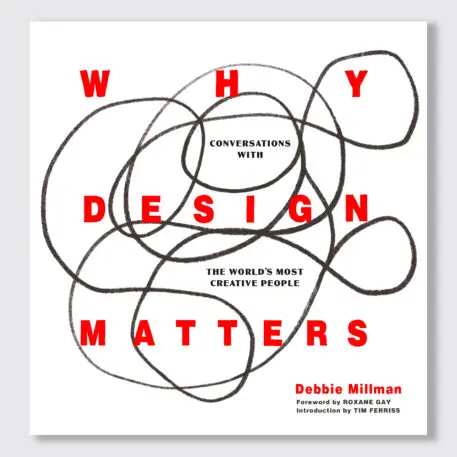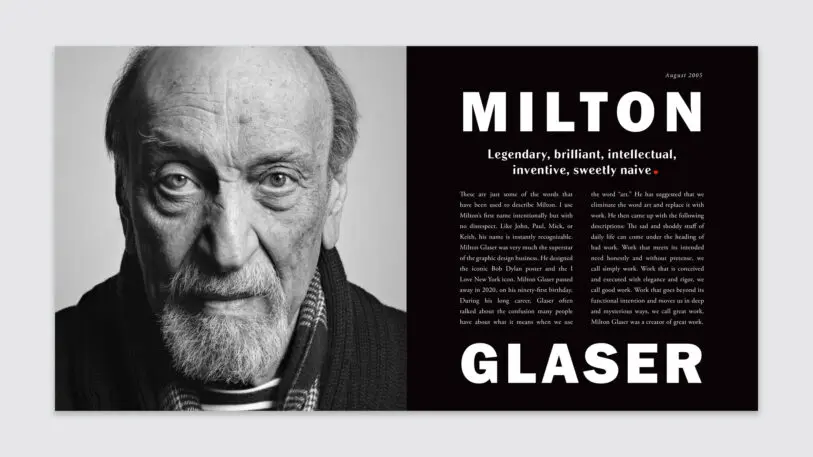When Debbie Millman launched her now-iconic podcast Design Matters in 2005, it was the very first podcast about design. Seventeen years later, the designer, educator, and branding consultant has expanded the definition of design to include a wild variety of creatives who make things happen, be it a book, a song, or a work of art. “It’s about a deliberate choice to create something,” she told me on a recent Zoom call.
As the host of Design Matters, Millman has conducted more than 400 interviews with a who’s who of creative minds, from Milton Glaser to Marina Abramović. Now, a new anthology features 55 of her most engaging conversations, coupled with soulful photography and playful graphics.


Fast Company: The first interviews on Design Matters were with your friends. Is it easier to interview people you know?
Millman: It was easy to talk to them and have a natural flow. But now that I know a little bit more about what I’m doing and do in-depth research that I didn’t do then, it’s much harder. One of my hardest interviews was with one of my best friends, Emily Oberman [now a partner at Pentagram], because I already knew so much that it felt inauthentic to be asking the questions that I was asking. But I wanted my audience to hear her origin story and to know her journey to where she was at that point. But I knew it so well, and she knew I knew it so well. It made it a lot harder.
Is she in the book?
She is. I interviewed her again. We did a do-over.
After starting with friends, how did you choose who sat in that chair across from you after that?
It was sort of a ripple effect. The first year or so were people I knew. I interviewed Milton [Glaser], but Milton was my teacher. At the time, it was a novel thing—an interview show about design—so most designers I asked were very agreeable about being in the show.

It’s still very much a show that follows my curiosity about my guests.
What is it in other people that you find interesting and worthy of an episode?
Primarily their body of work, the way they think about or talk about the journey to make that work. How candid are they with their struggles, or their obstacles, or their challenges? I’m interested in creative people who like to make things from nothing, whether it be a piece of music, or poetry, or performance, or design—anybody who is seeking to make something original.
After so many interviews, how did you narrow it down to the 55 featured in the book?
It was really tough. First and foremost, their interviews had to be timeless. I really wanted it to be removed from a specific body of work so that anybody could relate to it at any moment in time. Then, some conversations were so in-depth and didn’t hold up to editing, so I couldn’t include them. And third was: Can I get really soulful photography of this person?
Originally, pre-Covid, I was going to go on a photoshoot around the country and take photos of the guests that I chose, so I wouldn’t have to worry about that, but then I couldn’t do that.
What were the origins of the book?
I got the book deal right when I met Roxane [Gay], my now wife, in 2018. And so, I was like, “Book? I’m in love, I’m going to put it off because I’m in love!” So, I ended up getting an extension.
And then Roxane ended up doing your foreword.
She did. I got delayed a year because of love, then I got slammed by Covid because I couldn’t do the photoshoot as originally intended. So, despite the fact that I worked with 50 photographers in the book, I hope that the thread that runs throughout is the soul of these guests. At the very end, I was almost not going to be able to include Oliver Jeffers [a Northern Irish visual artist and author], but he ended up doing a photoshoot with me at the last minute, and I love that photo of him in his slippers.
The book is split into five chapters: Legends, Truth Tellers, Culture Makers, Trendsetters, and Visionaries. It must’ve been so difficult to categorize all of these icons, many of whom fall in all five categories at once.
Confession: Roxane helped me with that. I felt that there needed to be a way to organize them that also gave you permission to stop reading, or start in a different place. There’s absolutely no question that Thomas Kail, the director of Hamilton, is also a visionary and a culture maker [he’s featured under Trendsetters], so it was more about what’s the lead gene here? Everybody encompasses all of them, but I did feel like you could pick a lead gene and it would stick.
Going back in time a little, who came up with the title Design Matters?
It was me. I had to come up with a name within 24 or 48 hours. I love the little double entendre of it. Very shortly after I launched it, people were like, ‘Oh, it’s the same initials as your name.’
So that wasn’t intentional?
It wasn’t, it was an accident. And I didn’t have a logo for the first 10 years. I remembered that I’d won an illustration by Christoph Niemann from an AIGA New York auction fundraiser, and Christoph made the little face icon that I use. Armin Vit created the logo, and it’s been the logo ever since.
What made you go back to it so many years later?
I think I found it on my computer!
When did you start interviewing people other than designers?
Over the years, it’s just evolved. Now, it’s very much a show about all forms of creativity.
That extends to pretty much anything, right?
I haven’t interviewed a lot of athletes, but if Megan Rapinoe let me interview her, I’d do it in a second. I interviewed [soccer player] Abby Wambach and she’s an incredibly creative person, so it’s really a matter of how a person approaches their lives and how they approach making things happen in their lives.
When the scope broadened, the title of the podcast remained the same. I suppose it would’ve been a logistical branding nightmare to change it . . .
That is exactly why I haven’t done it. As somebody who has worked in branding for my entire professional career, this is a question that haunts me. It’s not technically a show about design anymore. However, I have so much equity that’s built in that name that I have a hard time thinking about what it would mean to let it go. At the end of the day, I really felt that design is everything and everything is design.
So, what is design exactly?
It’s about a deliberate choice to create something and make something. Whether we do that with our lives, or a piece of art, or a piece of music, or a piece of literature, or finding where memory resides in our brain, it’s all a deliberate choice about the kinds of lives we want to lead. It’s about how we design the arc of our lives and our careers.
Recognize your brand’s excellence by applying to this year’s Brands That Matter Awards before the early-rate deadline, May 3.
